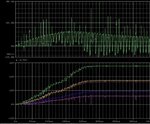sk614
Newbie level 5

I am simulating a flyback converter. So far I think things are working comparing the output voltages and hand calculations. However...I dont think the simulation is realistic. From the waveform, the top plot is the input current. Do I need to limit that current to make the simulation more realistic?
- - - Updated - - -
I think I want something like this in Pspice to limit the current.